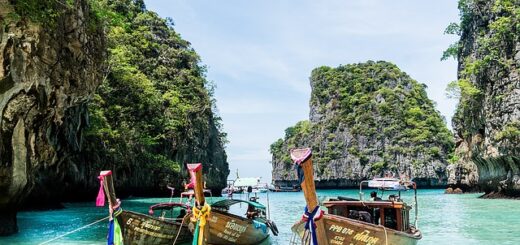Exploring the Outback: Red Sands, Iconic Landmarks, and Unique Wildlife
Australia’s Outback is a vast and mysterious region that captures the imagination of adventurers and nature enthusiasts from around the world. With its red sands, iconic landmarks, and unique wildlife, the Outback offers a truly unforgettable experience for those seeking to explore its rugged beauty.
Let’s embark on a virtual journey through this extraordinary landscape.

Stretching across the heart of Australia, the Outback is characterized by its arid and semi-arid desert regions. One of the most striking features of the Outback is its red sands, which give the landscape a mesmerizing and otherworldly appearance.
These vibrant hues are the result of iron oxide, which oxidizes over time, creating the rusty red color that blankets the terrain. As the sun sets over the Outback, the red sands come alive with a warm glow, providing a stunning spectacle for visitors.
One of the most iconic landmarks in the Outback is Uluru, also known as Ayers Rock. This massive sandstone monolith rises abruptly from the desert floor and is sacred to the Indigenous Anangu people, who have lived in the region for thousands of years.
Uluru is a UNESCO World Heritage site and holds cultural significance as a place of spiritual importance. Visitors can embark on a guided tour to learn about the traditional stories, art, and customs associated with this awe-inspiring landmark. As the day progresses, the colors of Uluru change dramatically, ranging from deep ochre to fiery red, creating a truly mesmerizing sight.
Another notable landmark in the Outback is Kata Tjuta, also known as the Olgas. These large domed rock formations are located just 25 miles west of Uluru and offer a unique and contrasting landscape. Comprised of 36 individual rock domes, Kata Tjuta is a haven for hikers and nature lovers.
The Valley of the Winds walk takes visitors through stunning gorges, offering panoramic views of the surrounding desert. The spiritual energy and natural beauty of Kata Tjuta make it a must-visit destination in the Outback.
While exploring the Outback, one cannot miss the opportunity to encounter its unique and diverse wildlife. Despite the harsh and arid conditions, the Outback is home to a range of fascinating creatures that have adapted to survive in this challenging environment. The kangaroo, with its iconic bounding hop, is perhaps the most recognizable Outback resident. These marsupials can be found grazing in the vast open plains, and lucky visitors might even witness them in their natural habitat. The Outback is also home to other iconic species like the emu, Australia’s largest bird, and the dingo, a wild dog that roams the desert.
For those interested in marine wildlife, the Ningaloo Reef is a hidden gem within the Outback region. Located off the coast of Western Australia, the Ningaloo Reef is the world’s largest fringing reef and a UNESCO World Heritage site. Snorkelers and divers can explore the vibrant coral gardens and swim alongside majestic creatures such as whale sharks, manta rays, and humpback whales. The pristine waters of the Ningaloo Reef provide a unique opportunity to witness an abundance of marine life in their natural habitat.
As one ventures further into the Outback, they will discover the rich Indigenous culture that has shaped this land for thousands of years. The Aboriginal people have a deep connection to the land and possess an intricate understanding of its natural resources. Many tour operators offer opportunities to engage with Indigenous communities and learn about their ancient traditions, art, and storytelling. These interactions provide visitors with a profound appreciation for the spiritual and cultural significance of the Outback.
In addition to its natural wonders, the Outback offers a range of outdoor activities for adventurous souls. From camel trekking across the vast desert plains to hot air balloon rides over the iconic landmarks, there are plenty of thrilling experiences to be had. Camping under a star-filled sky is a popular choice for those seeking a closer connection with the rugged wilderness. The Outback’s remoteness and lack of light pollution create a perfect setting for stargazing, allowing visitors to witness the brilliance of the Southern Hemisphere’s constellations.
Exploring the Outback is an adventure like no other, where the vastness of the landscape and the resilience of its wildlife leave a lasting impression. The iconic landmarks, such as Uluru and Kata Tjuta, provide a glimpse into the region’s rich cultural heritage, while encounters with unique wildlife offer an opportunity to connect with nature in its purest form.
Moreover, the Outback offers opportunities for adrenaline enthusiasts. The rugged terrain and vast expanses provide the perfect setting for off-roading and four-wheel driving adventures.
The Outback also offers a rich history of pioneering and mining. Towns like Broken Hill and Kalgoorlie tell the tales of the early settlers who ventured into the unforgiving landscape in search of fortune and a new way of life. Visitors can explore historic mining sites, visit museums, and even try their luck at prospecting for gold, experiencing a slice of the Outback’s intriguing past.
In conclusion, the Outback of Australia is a captivating destination that offers a unique blend of natural wonders, cultural heritage, and thrilling adventures. From the mesmerizing red sands and iconic landmarks like Uluru and Kata Tjuta to the diverse wildlife and opportunities for outdoor exploration, the Outback truly has something for everyone.
Whether you seek a spiritual connection with the land, an adrenaline-fueled adventure, or a chance to immerse yourself in the rich Indigenous culture, the Outback will leave you with memories that will last a lifetime. So, pack your bags, embrace the vastness of the Outback, get your 186 visa, and get ready to embark on an unforgettable journey into the heart of Australia’s rugged and awe-inspiring landscape.



















